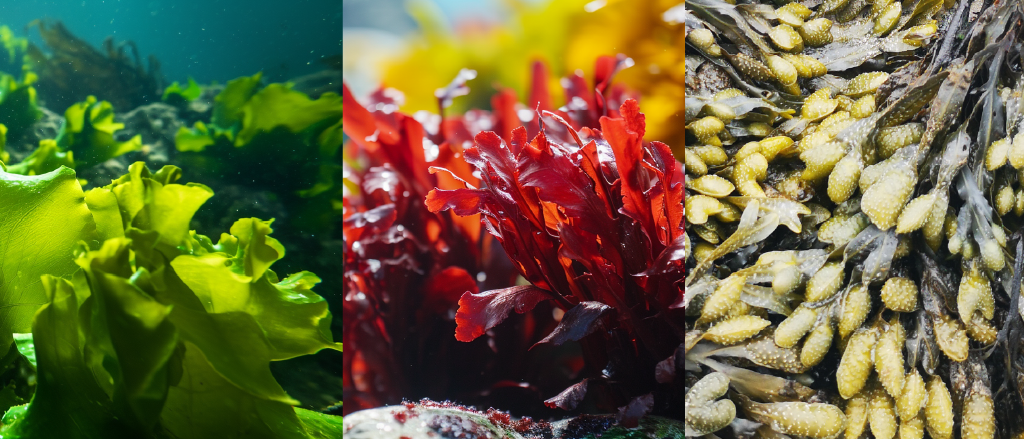What is Seaweed?
Seaweed is a common term used to describe multicellular marine algae which grow in our seas and oceans. These marine plants are extremely diverse and are generally classified into three groups which include brown, green and red algae. Regardless of classification, seaweed contains significant amounts of carbohydrates, proteins, lipids and vitamins which are all important nutrients. However, seaweed is perhaps best known for its high level of macro-minerals and trace elements which is reflected in the high ash content (8-45%) of seaweed when compared to land plants. Regardless of their classification, seaweeds are also rich in a number of biologically active compounds that provide health benefits beyond satisfying traditional nutrient requirements. As a result, seaweed and seaweed-derived compounds are currently being exploited as functional ingredients for both human food and animal feed applications. In total, there are over 10,000 species of seaweed divided among the red, green and brown groups/phyla and approximately 600 of these species can be found in Ireland.

Brown seaweeds (phylum Phaeophyceae)
Examples of brown seaweeds include Ascophyllum nodosum, Laminaria digitata and Fucus spp. These include kelps and wracks (for example, Laminaria digitata and Fucus vesiculosus respectively). Brown algae have a number of structural components including a holdfast which functions to secure the plant to a substrate such as rock.
The stipe is a stalk-like structure that functions to support the blade(s) which are the leaf-like elements of the seaweed. Blades have a large surface area which facilitates the exchange of nutrients with the surrounding water and also the absorption of sunlight for photosynthesis. This large surface area is important as, in contrast to land plants, seaweed does not have vascular tissue for the transport of nutrients. The colour of brown seaweeds is due to the presence of a number of pigments which are necessary for photosynthesis including fucoxanthin, which gives the seaweed its brown appearance.
Green Seaweeds (phylum Chlorophyta)
An example of green seaweed is the Ulva spp. which is better known as ‘Sea lettuce’. This seaweed is only two cells thick with a small holdfast and very little differentiation. Ulva lactuca is one of about 2000 species of green seaweeds, is irregular in shape and is similar in appearance to the leaf vegetable lettuce. The green colour of seaweeds such as Ulva lactuca and Codium fragile is due to the presence of chlorophyll a and b in addition to other pigments.
Sea lettuce is also known for its high levels of vitamin C and immune boosting properties.
Red seaweeds (phylum Rhodophyta)
Well known red seaweeds include Palmaria palmata (Dillusk/Dulse), Chondrus chrispus (Irish moss) and the Porphyra spp. (Nori/Laver). For example, Chondrus chrispus is relatively small seaweed, reaching a maximum of 15-20cm in length and has fan-like branches. The colour of red seaweeds is mainly due to the presence of the pigments phycoerythrin and phycocyanin, however, other pigments such as chlorophyll a and beta carotene are also present. The phylum Rhodophyta has the largest number of seaweed species (around 6000).
Uses of seaweed
Seaweeds have traditionally been utilised for the extraction of hydrocolloids such as alginates from brown seaweed and carrageenan from red seaweed. These hydrocolloids are used as thickeners, gelling agents, emulsifiers and stabilisers in the food industry and also for a number of additional applications. Seaweeds have also been utilised for bodycare and cosmetic applications as they are generally a rich source of vitamins, trace elements and iodine. Such applications include seaweed baths, shampoos, soaps and various topical creams. Seaweed is also used as a fertiliser (as a dried product or liquid extract), in medicine, as an ingredient in human food, textiles and is currently being researched for biofuel production. Traditionally, single species of brown seaweeds such as Ascophyllum nodosum have been utilised as a feed ingredient for cattle, sheep and other animals. This usage was historically limited to coastal regions due to the difficulty in transporting the heavy biomass inland. In recent years, interest in the use of various seaweed species for both human food and animal feed has increased due to an excellent nutritional profile and the potential health benefits that can be obtained from a 100% natural resource in an environmentally friendly and sustainable manner.
Suggested further reading
Holdt SL, Kraan S (2011) Bioactive compounds in seaweed: functional food applications and legislation. J Appl Phycol 23:543-597.
Morrissey J, Kraan S, Guiry MD.
A Guide to Commercially Important Seaweeds on the Irish Coast. Dublin, Bord Iascaigh Mhara/Irish Fisheries Board; 2001:5–40.





